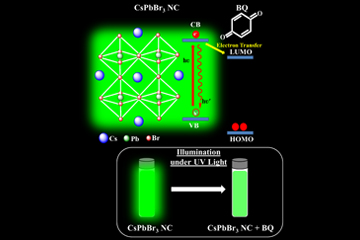 Dr Nimai Mishra, Assistant Professor, Department of Chemistry, SRM University-AP, Andhra Pradesh, along with his research group comprising of students pursuing PhD under him, Mr Syed Akhil and Ms V G Vasavi Dutt have published a research article titled “Surface Modification for Improving Photoredox Activity of CsPbBr3 Nanocrystals” in the Journal “Nanoscale Advances” (The Royal Society of Chemistry).
Dr Nimai Mishra, Assistant Professor, Department of Chemistry, SRM University-AP, Andhra Pradesh, along with his research group comprising of students pursuing PhD under him, Mr Syed Akhil and Ms V G Vasavi Dutt have published a research article titled “Surface Modification for Improving Photoredox Activity of CsPbBr3 Nanocrystals” in the Journal “Nanoscale Advances” (The Royal Society of Chemistry).
Inorganic lead halide perovskite nanocrystals (PNCs) are used in photocatalytic reactions in the modern era. The surface chemistry of the PNCs can play an important role in the excited state interactions and efficient charge transfer with redox molecules. In this work, Dr Mishra’s research group explored the impact of CsPbBr3 nanocrystal surface modification on the excited state interactions with the electron acceptor benzoquinone (BQ) for three different ligand environments: as oleic acid/oleylamine (OA/OAm), oleic acid (OA)/ trioctylphosphine (TOP), and oleic acid (OA)/ oleylamine (OAm)/ trioctylphosphine (TOP) ligands.
 The research infers that amine-free PNCs (OA/TOP capped) exhibit the best-excited state interactions with benzoquinone as compared to the conventional oleylamine ligand environment. The photoinduced electron transfer (PET) rate constants were measured from PL-lifetime decay measurement. The amine-free PNCs show the highest PET which is 9 times higher than conventional ligands capped PNCs. These results highlight the impact of surface chemistry on excited-state interactions of CsPbBr3 NCs and in photocatalytic applications.
The research infers that amine-free PNCs (OA/TOP capped) exhibit the best-excited state interactions with benzoquinone as compared to the conventional oleylamine ligand environment. The photoinduced electron transfer (PET) rate constants were measured from PL-lifetime decay measurement. The amine-free PNCs show the highest PET which is 9 times higher than conventional ligands capped PNCs. These results highlight the impact of surface chemistry on excited-state interactions of CsPbBr3 NCs and in photocatalytic applications.
More importantly, this work concludes that amine-free PNCs maintain a redox-active surface with a high photoinduced electron transfer rate which makes them an ideal candidate for photocatalytic applications.
To read the full paper: Please Click Here

